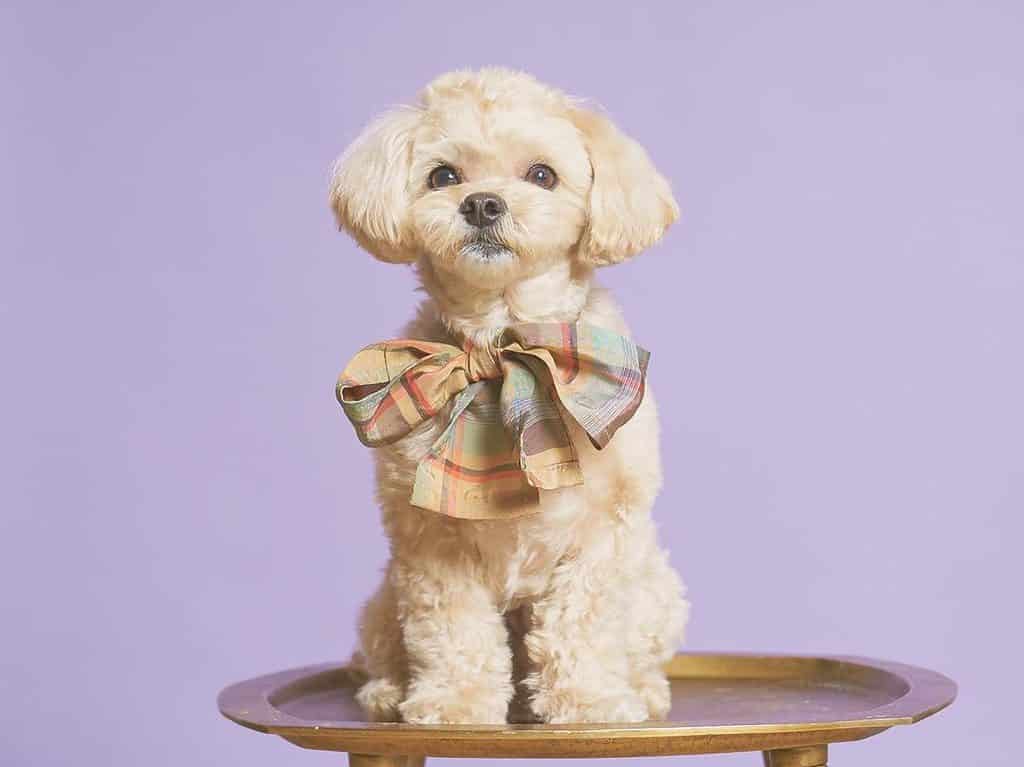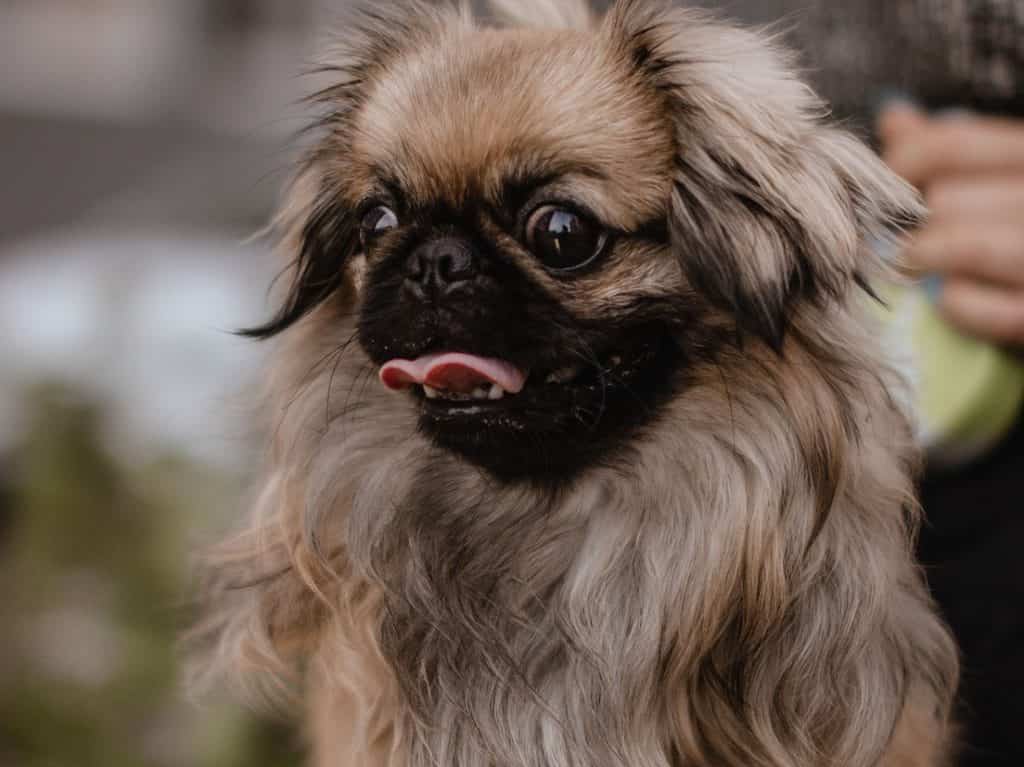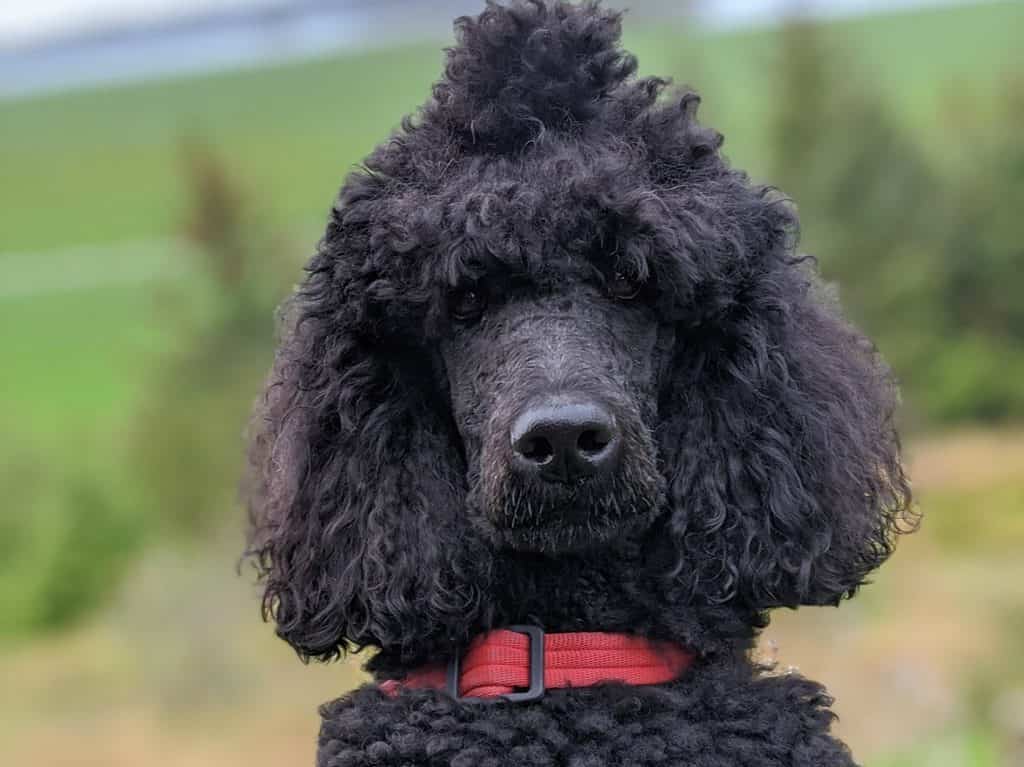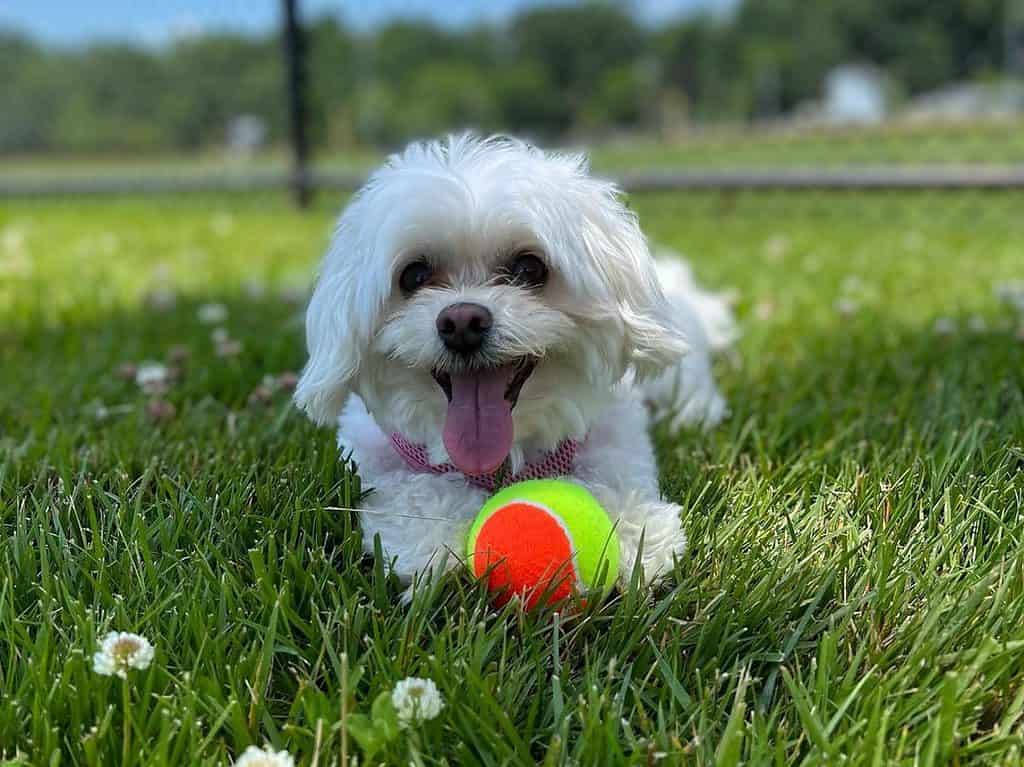If you’ve ever been startled by an especially loud greeting from a Peekapoo you met for the first time, don’t be afraid. Though these dogs are quite barky, don’t let that fool you into thinking they are aggressive; in fact, the opposite is true. Beneath those loud barks lies an undeniably affectionate and devoted companion.
Who could resist this mix of two very lovable breeds; Pekingese and Poodle? We think it’s an adorable combination that certainly isn’t short on personality!

Quick Facts: Peekapoo
Height
6 - 11Weight
4 - 20Lifespan
10 - 15Breed Size
small (0-25 lbs.)Breed Type
mixedBreed Group
companionTemperament
anxious, gentle, outgoing, playful, protective, strong-willed, affectionate, loyal, activeGood With
families, other dogs, catsIntelligence
highShedding
infrequentExercise Needs
highBarking Level
highEnergy level
highDrool Amount
lowCoat Type
soft, curl or wavyCoat Patterns
bi-colorColors
black, brown/chocolate, cream, gray, red, white, silver fawn, apricotOther Characteristics
apartment-friendly, prone to health issues, strong loyalty tendencies, tendency to chewPeekapoo Highlights
- The Peekapoo is well-suited for apartment living; however, it would benefit from access to outdoor space to satisfy its physical and mental needs.
- Peekapoos can suffer from separation anxiety if left unaccompanied for an extended duration.
- Positive reinforcement techniques can be utilized to train Peekapoos effectively.
- The Peekapoo is recognized for its affectionate demeanor and calm disposition, making it an ideal pet for older children with a more mature understanding of responsible pet ownership.
- Peekapoos are well-known to be vocal, as they bark enthusiastically at strangers or unfamiliar objects. In addition, their tendency to make vocal sounds makes them reliable watchdogs.
- These dogs are prone to overheating and should be kept in air-conditioned homes.
History
The Peekapoo breed has a relatively long history as a “designer dog” and, through responsible breeding practices, could potentially have its history extended. The crossbreeding between a Pekingese and a Poodle, which had not been done previously, was first realized in the 1950s and 1960s. This mixed breed represented one of the initial crosses from such Poodle breeds at that time. Despite the fact that this first-ever Peekapoo has not achieved the same degree of public approval enjoyed by other designer breeds, it is evident that there is sufficient admiration for it to sustain its continuing presence.
The Peekapoo was selectively bred to be the ideal companion for individuals suffering from allergies. It is important to note that, despite significant efforts on behalf of the breeders, some Peekapoos still have coats that can cause allergic reactions. Nevertheless, many homes have embraced the little companion as a faithful pet, while some have recognized their usefulness as therapy dogs.
Learn more about the history of Peekapoo through its parent breeds.
Pekingese

The Pekingese dog, known in the West as the “Peke”, has been an esteemed canine companion in China for centuries. It is uncertain when the Chinese initially began to breed the Pekingese selectively, yet they have been associated with reigning emperors in China since the 7th century.
Through explicit direction by monarchs, Pekingese dogs were bred to be tiny replicas of lions native to the grasslands. This is clear in the resemblance they bear to these iconic beasts.
These days, the Pekingese dog breed may be seen in various parts of China. Since the country has shifted to a form of Communism, such dogs are no longer exclusive to the imperial family; they are now open to ownership by all citizens.
Poodle

Over the years, Poodles have progressed in their roles and occupations due to their favorable qualities. Due to this, they have become widely desired dogs for many other purposes besides hunting.
The Poodle was bred to be a highly proficient retriever, and the modern breed shows ample evidence of its aptitude. This is supported by the continued documentation of its ability to retrieve effectively.
As a testament to the breed’s capability, Poodles are adept swimmers. It should not be assumed that all Poodles are skilled swimmers; nonetheless, they possess the necessary reflexes for the sport.
Appearance

Because the Peekapoo is a mixed breed, there are no formal guidelines indicating what a pup’s appearance should be. The appearances can be quite diverse and manifest attributes inherited from both parent breeds.
One thing is for sure, the Peekapoo has a shorter muzzle than the Poodle, leaving them with an increased vulnerability to particular respiratory issues.
Peekapoo Size
Since there is no established breed standard for the Peekapoo, breeders have no distinct parameters to adhere to. As a result, this dog is found in various sizes. The Peekapoo typically grows to a maximum height of 11 inches, with a range in weight from 4 to 20 pounds.
Peekapoo Colors
Their coat colors range from black and chocolate to apricot and cream, with additional variation including red, sable, white, gray and silver. Moreover, they can also display various markings, such as phantom and white.
Coat
The Peekapoo breed is distinguished by its luxuriously soft coat, which may range from curly to wavy in texture.
Personality


Peekapoos are always up for long walks or a game of fetch in the yard. However, such activities should not be overdone to avoid respiratory distress.
Moreover, they are typically compatible with members of their household. They live best with older, more conscientious kids and must be exposed to children from a young age.
Unfortunately, this mixed breed is suited for companionship and cannot tolerate being left alone for extended periods. This can lead to feelings of isolation and distress which often cause the dog to become destructive.
Peekapoos are often quite vocal, emitting barks when they encounter something or someone out of the ordinary. Although this can be a nuisance sometimes, it certainly serves as an effective alert system.
Socialization is an absolute requirement for the Peekapoo due to its inherent wariness of unfamiliar individuals or canines. Without the appropriate socialization, the Peekapoo may demonstrate aggressive behavior. This is a common issue among all dog breeds, particularly those accustomed to being cautious in unfamiliar environments.
To ensure the socialization of your young Peekapoo is successful, enrolling them in a puppy kindergarten class is a beneficial starting point.
Health
The Peekapoo may be prone to inheriting the health issues of its parent breeds, including but not limited to:
Progressive Retinal Atrophy
Progressive Retinal Atrophy is an eye disorder that affects many dog breeds with devastating consequences. This condition can cause a gradual decrease in the ability of dogs to see, and for some, unfortunately, complete blindness can occur. Early diagnosis and treatment are key to ensuring your pup has the best chance of maintaining sight.
Patellar Luxation
This occurs when the kneecap, or patella, slips out of its normal position in the knee joint and becomes luxated or dislocated. This can cause significant pain and discomfort to your pup.
If your pup is displaying signs of Patellar Luxation, such as limping or difficulty walking, it’s important to seek veterinary advice immediately to prevent further damage and ensure a speedy recovery for your beloved pet.
Collapsing Trachea
Also known as tracheal collapse, this medical condition affects small dogs more than larger breeds and is characterized by the weakening of the cartilaginous rings that line the windpipe. In some cases, these collapsed rings can even completely obstruct airflow.
This problem is also quite common among small dogs, especially those with a brachycephalic breed, such as Pugs, Poodles, Pekingese, Pomeranians, Shih-Tzus, Bulldogs, and Chihuahuas.
Lifespan
On top of their wonderful personalities, the Peekapoo can also live long lives, up to 15 years, if well looked after.
Care
The Peekapoo should be provided ample daily physical activity to maintain its mental and physical well-being. Otherwise, insomnia, poor socialisation skills and destructive habits may develop due to repressed energy.
But remember this: avoid exercising a Peekapoo excessively; this breed can quickly suffer from heat exhaustion leading to respiratory difficulties. It is also worth noting that smaller, high-energy Peekapos will not require the same level of physical activity as larger dog breeds.
Training a Peekapoo should be conducted exclusively with positive reinforcement in order to prevent any potential harm that corrective methods could cause.
A Peekapoo can adapt to various living situations, including apartment-style dwellings; however, they exhibit a greater level of comfort when provided with a small area outdoors to roam around and play. Do not leave Peekapoos outside unattended, as they may be at risk of becoming prey for larger animals in the vicinity.
Furthermore, crate training is an important part of a responsible dog owner’s routine. It can provide the Peekapoo with a safe space to limit messes in the house and restrict access to potentially dangerous items.
Diet
Owners typically select dry food for their pets to ensure they receive all the essential nutrients. A diet comprising high-quality kibble is also optimal for a Peekapoo.
Pay attention to the ingredients’ quality when selecting a pet food brand. Opt for premium brands and avoid buying low-quality options full of fillers and inadequate protein content.
The portion size of your pet’s food depends upon the brand; however, a typical daily amount is between one-quarter and three-quarters of a cup. Occasionally, you may supplement your pet’s feedings with additional sources of nutrition such as dog-safe vegetables, fresh meat, and wet canned food. But this should be done in moderation to avoid an inadvertent increase in caloric intake.
Grooming
The coat of a Peekapoo requires routine grooming and proper care to remain untangled, healthy, and clean. Establish a routine for brushing your Peekapoo puppy early on. Ensure that the experience is pleasant, complimenting and rewarding your pup to help lay the groundwork for easier veterinary care in the future.
If you don’t have time to do the grooming yourself, take your Peekapoo to a professional groomer.
Also, clean their ears weekly for evidence of dirt, redness or foul smell, which could indicate infection. To maintain ear health, use a cotton ball moistened with a pH-balanced cleaning solution.
Brush your Peekapoo’s teeth at least twice a week to reduce plaque build-up and mitigate bacterial growth.
Peekapoo Puppies
The number of puppies in a Peekapoo litter may be up to 6, and the acquisition cost for each puppy is approximately $500 – $2000.
The price can change depending on the locality of the breeder, the pedigree or lineage of the parent breeds and how esteemed their kennel is in general. Exercise caution when selecting a breeder and thoroughly research the process beforehand. We strongly recommend that you visit the kennel or breeding location first. A visit to the kennel will allow you to meet your potential pup’s parents and siblings and see how they are kept in their environment.
Children and Other Pets
The Peekapoo is noted for its energetic nature and prefers engaging in ball-chasing activities rather than a sedentary lifestyle. While most Peekapoos are compatible with other pets that share their activity level, this breed is likely not suitable for households with small children. The size of the Peekapoo puts them at risk of being hurt by children; for this reason, you must supervise interactions between these pups and young kids.
Rescue Groups
Although no official rescue groups are dedicated to Peekapoos specifically, it’s possible that the ones with rescued Pekingese and Poodle breeds may also have Peekapoos.
Michigan Standard Poodle Rescue
Pekingese Charitable Foundation
Peekapoo FAQS
Are Peekapoos low-energy dogs?
No. Peekapoos have boundless energy, love spending time outdoors, and thrive when they get plenty of exercise. With their stamina and enthusiasm for physical activities, many owners find that these pups can easily walk for almost an hour with minimal breaks.
However, when it comes to exercising your Peekapoo, make sure that you don’t go overboard and over-exert them. These lovable and cuddly dogs have flat faces, making them prone to respiratory problems due to their small airways.
Creating and following a well-planned schedule can ensure your Peekapoo is able to get the necessary physical activity it needs. This can range from daily walks, playtime sessions with their favorite toy, or visits to their local dog park.
Are Peekapoos hard to train?
Yes. Training these dogs can be tricky. Utilizing positive reinforcement is necessary to ensure effective training of this breed, as other methods (like yelling or any other form of reprimanding) are unlikely to be successful.
How much does a Peekapoo cost?
A Peekapoo can cost anywhere between $500 and $2000. Note that Peekapoo puppies with particular colors or markings might cost more than others without them.
Are Peekapoos naturally suspicious?
Yes. Peekapoo dogs have a level of wariness around unfamiliar people. With proper socialization training, these loyal pups will learn how to control their barking, so it’s not too excessive or disruptive in public places like parks or busy streets.
Do Peekapoos live long?
Yes. This breed can live up to 15 years if given proper care and attention.
Peekapoo Fun Facts
- In 2019, the Daily Telegraph announced @coco_the_peekapoo as Sydney’s Pet of the Year; her Instagram account currently boasts more than 80,000 devoted followers.
- The Peekapoo is a remarkable breed that demonstrates an impressive level of loyalty, protectiveness, and determination despite its small size.
- The Peekapoo is alternatively referred to as the Pekingese Poodle Mix, Peke a Poo, Pekepoo, and Pake-A-Po.
References
Di Dona, F., Della Valle, G., & Fatone, G. (2018). Patellar luxation in dogs. Veterinary Medicine: Research and Reports, 9, 23.
Bosio, F., Bufalari, A., Peirone, B., Petazzoni, M., & Vezzoni, A. (2017). Prevalence, treatment and outcome of patellar luxation in dogs in Italy. Veterinary and Comparative Orthopaedics and Traumatology, 30(05), 364-370.
Payne, J. D., Mehler, S. J., & Weisse, C. (2006). Tracheal collapse. Compendium, 28(5), 373-381.




